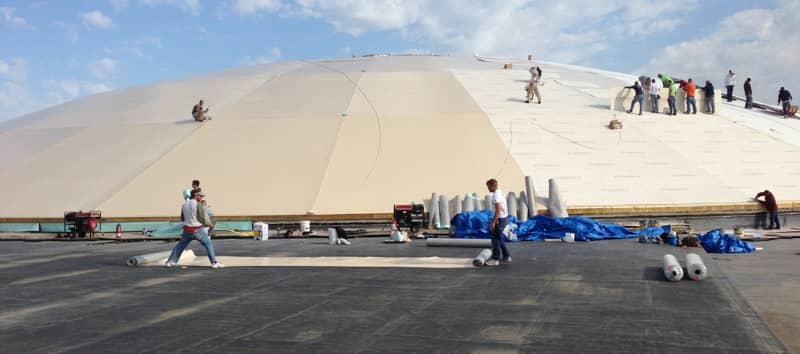 Commercial roofing, as we know it today, was founded on Built-up Roofing (BUR). BUR is composed of layers of roofing felts adhered together, most commonly by asphalt. To achieve this, the asphalt is melted and spread / mopped onto the roofing felts, with additional felts laid into the melted asphalt. Asphalt was, and is, used as an adhesive.
Commercial roofing, as we know it today, was founded on Built-up Roofing (BUR). BUR is composed of layers of roofing felts adhered together, most commonly by asphalt. To achieve this, the asphalt is melted and spread / mopped onto the roofing felts, with additional felts laid into the melted asphalt. Asphalt was, and is, used as an adhesive.
With the advent of single ply roof membranes, and their proliferation in the 80’s and 90’s, a number of installation means were employed. The most common types were ballasted, mechanically attached, and adhered systems (the smallest share of the market). Initially, adhered systems were considered difficult and expensive to install, and the stereotypical liquid adhesive products being employed were still in a learning curve, leading to questionable reliability of performance.
Over the years, commercial roofing system manufacturers and their adhesive vendors have refined and advanced the technology associated with liquid adhesive products for the various and specific types of single-ply roof membranes, as well as the application of those products. The types or classifications of these liquid adhesives have expanded to serve the market needs: solvent-based, water-based, low VOC, etc. Today, it’s common for a commercial roofing system manufacturer to have eight or more types/classifications of adhesives in their product portfolio, including asphalt. In general, the application for each of the typical liquid adhesives involves mixing the adhesive by stirring it (and keeping it mixed), temperature limitations, specific quantity of application per square foot (by paint roller or spray equipment), etc.
If you are the roofing contractor this presents a number of challenges:
- Making sure the correct adhesive is selected (all have different price points)
- Knowing how to properly store adhesives (they all have specific shelf lives and storage requirements)
- Training roofing installation crews to ensure they know how to use the adhesives for each specific project
Entering the Market: Low-Rise Foam Adhesive
In recent years, a new type of adhesive technology has gained momentum in the market: low-rise foam adhesive for adhering fleece-backed, single-ply roof membrane. Typically, low-rise foam adhesives are supplied in self-contained, ready to dispense kits. As the product is applied by spraying it, the portable kits make it easy to access hard-to reach areas, while also providing faster application on open roofs. Applying the product by spraying it in a simple “spatter pattern” eliminates the need for expensive foam spray equipment as well as eliminates the tedious and variable application of a liquid adhesive out of a bucket with a paint roller, making it 2 – 3 times faster to apply. Other advantages include:
- Mitigating the telegraphing irregularities of the substrate from showing through the roof membrane
- Green-strength bonding typically occurs in 10 - 20 minutes, while typically achieving 80 - 90% cure within 2 hours of application (liquid adhesives tend to exhibit low green-strength bonding and can take days or weeks to cure)
Overall, low-rise foam allows contractors to adhere single-ply roofing membrane more efficiently than before.
What other advantages does low-rise foam bring to the roofing industry? Tell us about it in the comments.
-1.png?width=500&height=271&name=FiberTite_Only%20(500px%20wide)-1.png)


-1.png)